
After witnessing some overs of the 2024 IPL final, you pondered whether to observe the action closely and write down certain points. Almost every ball ushered in by Kolkata Knight Riders’ six-member attack had a ring of excellence attached to it, so observing the finer points of the game didn’t seem to matter much. It was time to sit back on a sofa and enjoy some perfection at work. Not so much for Sunrisers Hyderabad, KKR’s opponent in the summit clash.
The first over bowled by Mitchell Starc itself would have sent a few shivers down the spine of the SRH camp. Starc once more tormented the SRH openers, and this time it was the turn of the hapless Abhishek Sharma. With Travis Head having an unfavourable match-up against Starc, the SRH think-tank had somewhere decided that Abhishek would take first strike. Unfortunately for the franchise, both have similar methods. In such a scenario, Starc was set to trouble both of them.
The pro set-up Abhishek with a volley of outswingers before castling him with a peach that angled in before leaving the batter off the deck to shatter the stumps. The plan – offer Abhishek no width, zoom the ball on the stumps and hope for seam movement – was very good. The implementation of it was even better.
Then there was Vaibhav Arora, the seamer from Himachal Pradesh. He was all geared up to execute perhaps the most difficult plan while bowling to Head. The initial trajectory of the ball was on a leg-stump line. Then it swung away a tad and carried on its path even more to take the edge on an off-stump line. So, why is it not easy to put such a plan into practice?
Head’s back foot doesn’t move across much, and if it is bowled in the corridor of uncertainty, then there is a chance of it whistling past the outside edge. This offering was bang on off-stump, and the resultant outcome had to be Head nicking one behind. In an imaginary scenario, if Vaibhav’s practical paper was set for 100 marks, he would have got 100/100 for the implementation part.
Harshit Rana, too, has come up by leaps and bounds over the last one year. In the final, he didn’t just pound the pitch hard but also extracted consistent seam movement at a burst of pace to leave the batters’ techniques in a disarray. Nitish Reddy was one of them to be bamboozled. For a brief period, Nitish was showing measured judgment in conditions where the ball was doing a bit in the air and off the deck.
However, he had no answer to a delivery that was angled back in from mid-crease and then moved away after pitching to take the edge. A purist might point to Nitish being squared up, but in reality that kind of a nut would have troubled batters with a lot more experience than the young all-rounder.
On the given night, there was no respite for SRH as they still had to face the two bankable options of the Kolkata side – the spin duet of Varun Chakaravarthy and Sunil Narine. It shouldn’t come as a surprise that the twosome went for a mere 25 runs from six overs and bagged two wickets between them. The bigger surprise this season has been Andre Russell again finding his zone with the ball. Right through the course of the tournament, he hit the deck hard and blended it with different lengths to scalp 19 victims. Yes, a whopping 19 scalps. Three of them came in the final.
One of his three victims was Pat Cummins. The SRH skipper, who was also the last man to fall, might have grudgingly appreciated what took place in front of his eyes. Over the years, Cummins has taken down opponents with his relentless hit-the-deck bowling, supplemented by movement.
As the captain sitting in the dug-out for most part of the innings, he was at the receiving end of such a masterclass: everything was flowing effortlessly and all the bowlers seemed to be operating on the back of an automated switch. It was a magnificent performance. And they were miserly too.
From an ordinary start to the tournament and hearing lot of words about his price tag to proving his detractors wrong, Mitchell Starc has demonstrated his champion qualities.
Let’s appreciate the lethal bowling prowess of this Aussie pacer.@BoriaMajumdar @ShrachiSports… pic.twitter.com/ktOel5W8C0
— RevSportz (@RevSportz) May 26, 2024



